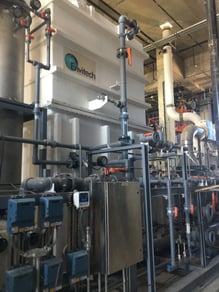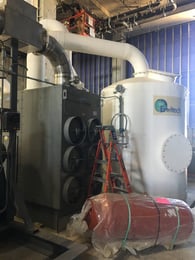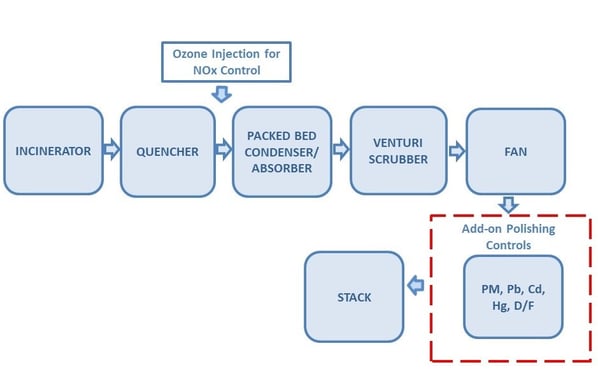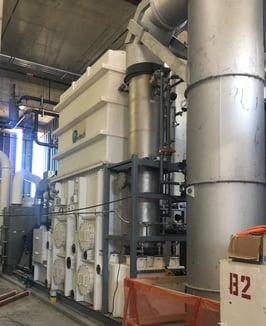Early this year I posted about achieving ultra-low emission limits for medical waste incinerator scrubbers. An example was given for a captive incinerator at the University of Texas Medical Branch (UTMB) in Galveston, TX. It’s one of the only systems in the United States permitted as a “new” medical waste incinerator according to the EPA HMIWI (hospital, medical, and infectious waste incinerator) MACT standard. This standard has the most challenging emission limits found in industry today. That is because in 2009 the EPA completed a source review and revised the standard based on a MACT-on-MACT analysis. Data used to set limits for each pollutant was individually based on waste feed and not incinerator/scrubber technology performance. This resulted in emission limit reductions for lead (Pb), cadmium (Cd), and dioxins/furans (D/F) that were orders of magnitude below the previous standard and below the capability of installed equipment. The impact of the new standard is discussed in greater detail in a 2013 blog post and corresponding paper from the Air & Waste Management Association (AWMA) International Conference on Thermal Treatment Technologies and Hazardous Waste Combustors (IT3/HWC)..
An example was given for a captive incinerator at the University of Texas Medical Branch (UTMB) in Galveston, TX. It’s one of the only systems in the United States permitted as a “new” medical waste incinerator according to the EPA HMIWI (hospital, medical, and infectious waste incinerator) MACT standard. This standard has the most challenging emission limits found in industry today. That is because in 2009 the EPA completed a source review and revised the standard based on a MACT-on-MACT analysis. Data used to set limits for each pollutant was individually based on waste feed and not incinerator/scrubber technology performance. This resulted in emission limit reductions for lead (Pb), cadmium (Cd), and dioxins/furans (D/F) that were orders of magnitude below the previous standard and below the capability of installed equipment. The impact of the new standard is discussed in greater detail in a 2013 blog post and corresponding paper from the Air & Waste Management Association (AWMA) International Conference on Thermal Treatment Technologies and Hazardous Waste Combustors (IT3/HWC).. Existing incinerators needed to be upgraded with add-on controls to meet the new standard. New incinerators need air pollution control equipment capable of extraordinarily high removal efficiency for particulate, Pb, Cd, and D/F. A new medium sized incinerator between 200 to 500 lb/hr capacity, has the additional challenge of meeting NOx. A medical waste incinerator can be tuned to a NOx limit of about 130 ppmv. The MACT standard limit for a new medium sized medical waste incinerator was set at 67 ppmv which means NOx abatement is required to guarantee compliance.
Existing incinerators needed to be upgraded with add-on controls to meet the new standard. New incinerators need air pollution control equipment capable of extraordinarily high removal efficiency for particulate, Pb, Cd, and D/F. A new medium sized incinerator between 200 to 500 lb/hr capacity, has the additional challenge of meeting NOx. A medical waste incinerator can be tuned to a NOx limit of about 130 ppmv. The MACT standard limit for a new medium sized medical waste incinerator was set at 67 ppmv which means NOx abatement is required to guarantee compliance.
Envitech is building two scrubber systems to treat exhaust gases from two new medical waste incinerators that will treat captive waste at a research facility. The incinerators are permitted as new medium size incinerators which must meet the 67 ppmv NOx limit. The scrubbers have an equipment arrangement for meeting emission standards for PM, HCl, SO2, Pb, Cd, Hg, D/F, and opacity. The schematic below shows the components of the gas cleaning system. The quencher is used to cool the gas to saturation and remove large particulate. The packed bed condenser/absorber sub-cools the gas and removes acid gases with caustic injection. The Venturi scrubber removes particulate and the majority of heavy metals. The gas then passes through additional polishing controls to meet the ultra-low emission limits for Pd, Cd, Hg, and D/F. The polishing equipment includes a re-heat duct followed by a filter and carbon bed adsorber.
NOx removal is achieved by injecting ozone injection into the quencher outlet. The siz e of the condenser/absorber is increased to provide sufficient residence time for ozone-NOx reactions to occur. Ozone is highly selective for NOx relative to other combustion products. The NOx is rapidly converted to water soluble species. NO and O3 react to form NO2 and O2. NO2 and O2 react to form N2O5 and O2. N2O5 and water react to form 2HNO3 which is readily absorbed with caustic solution.
e of the condenser/absorber is increased to provide sufficient residence time for ozone-NOx reactions to occur. Ozone is highly selective for NOx relative to other combustion products. The NOx is rapidly converted to water soluble species. NO and O3 react to form NO2 and O2. NO2 and O2 react to form N2O5 and O2. N2O5 and water react to form 2HNO3 which is readily absorbed with caustic solution.
Envitech used it’s rectangular scrubber design for the condenser absorber. To maintain a modular design and make it shippable. The vessel was flanged connected and shipped in two pieces. The scrubber system otherwise looks like a typical medical waste incinerator scrubber except the condenser/absorber is double the height compared to systems that do not require NOx control.
The system has been built and shipped to the site. The major components are installed at the facility. Envitech will deliver a water treatment system in 2019 to treat the scrubber effluent before it is discharged to the facilities main water treatment system. System Start-up is scheduled for 2020.
Click on the link below to download a case study and other medical waste incinerator scrubbing literature.


